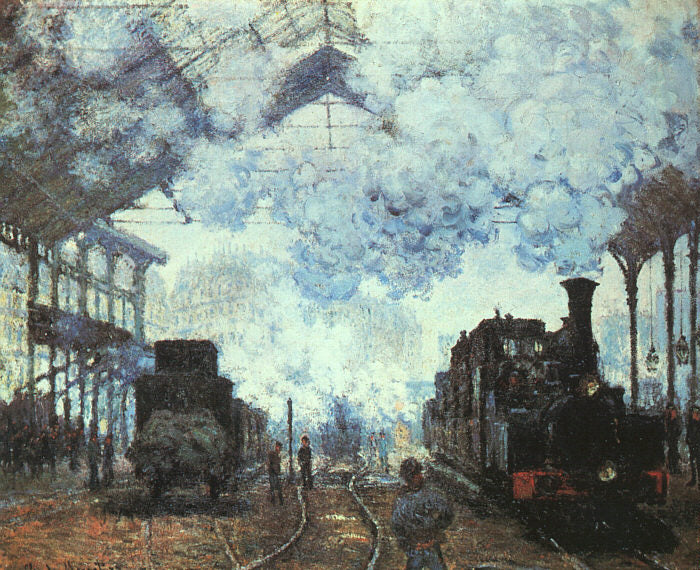Description
Claude Monet's Gare St.-Lazare: Arrival of a Train (1877) is a seminal piece not only in the artist's career but also in the history of Impressionist art. Capturing the hustle and bustle and energy of one of Paris' most iconic train stations, this painting stands as a testament to the advent of modernity and the urban transformation that characterized the era.
In this work, Monet uses a careful composition that, at first glance, appears chaotic, but is in fact meticulously balanced. The train, which is given a central and almost monumental focus, becomes the undisputed protagonist of the scene. The locomotive emits steam, which mixes with the humid air of the environment and is diffused by the use of loose and rapid brushstrokes, a distinctive feature of Impressionism. This use of steam is not only a literal representation of the train, but also an allegory of progress and industrialization that, in the 19th century, reshaped not only the urban landscape but everyday life in general.
Colour plays a fundamental role in the work. Monet makes use of a palette in which grey and blue tones predominate, which are intertwined with yellow and orange hues. These colours not only reflect the artificial lighting of the station, but also evoke an almost dreamlike atmosphere. Through his loose brushstrokes, Monet captures the light in its many facets, allowing the viewer to experience the transience of the scene. The reflection of the train on the wet pavement adds an element of depth and complexity, inviting the viewer to immerse themselves in the triple dimensionality that the artist managed to capture.
One observation worth noting is the inclusion of human figures, albeit in a fragmented and almost anonymous way. These silhouettes, moving through the station, seem to be part of a larger landscape. This treatment of the human figure is emblematic of Impressionism, which prioritized the capture of moment and atmosphere over the individualization of subjects. People become mere elements of the environment, reinforcing the idea that the train station is a crossroads and a space of social interaction in constant motion.
Gare St.-Lazare is part of a series of works that Monet dedicated to the station, where he experimented with light and atmosphere at different times of the day and its impact on the perception of architectural space. This repetitive and studious approach reflects Monet's curiosity about the ephemeral nature of life, a recurring theme in his work. Furthermore, "Gare St.-Lazare: Arrival of a Train" is a clear precursor to later developments in modern art, where abstraction and subjectivity would continue to evolve.
This painting has been interpreted not only as a depiction of an everyday event, but also as a metaphor for the modern era, a time when art began to free visual representation from the demands of strict realism. When looking at the work, the viewer is invited to reflect on the impact of technological progress on human life, evoking a sense of nostalgia and admiration simultaneously.
In conclusion, “Gare St.-Lazare: Arrival of a Train” is more than just a painting of a train arriving at a station. It is a profound examination of time, change and light, captured by one of the great masters of Impressionism. Monet provides us, through his masterful technique and artistic sensitivity, a window into a rapidly changing world, offering a perception of the environment that still resonates with the relevance of our own contemporary times.
KUADROS ©, a famous painting on your wall.
Hand-made oil painting reproductions, with the quality of professional artists and the distinctive seal of KUADROS ©.
Painting reproduction service with satisfaction guarantee. If you are not completely satisfied with the replica of your painting, we will refund 100% of your money.

